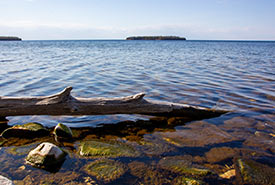What we know about lake-safe sunscreen

Shoreline of a lake (Photo by Salome Guruli via Unsplash)
I always felt very lucky that I didn’t inherit my mother’s propensity to sunburn. I wore sunscreen constantly as a child because I was afraid I’d turn crispy from mere moments in the sun. To this day, I always wear sunscreen on bike rides or hikes. Every health class I took in school made me weary of the risks of skin cancer, so I did not want to take any chances. Like many people, I hadn’t stopped to think if the products meant to protect my skin were polluting the lakes I was swimming in. However, research from the last decade is showing that there could be a connection between the decline of certain marine species and sunscreen chemicals.
Sunscreen ingredients and what the science says
Oxybenzone and octinoxate are the two main ingredients at the centre of the debate as to whether or not certain sunscreen chemicals are toxic to marine life and should be banned. In 2016, a study was published by the Archives of Environmental Contamination and Toxicology that examined the potential link between these chemicals and coral reef damage. The study found that oxybenzone poses a hazard to coral reef conservation. As a result, places that have banned sunscreens with these ingredients include Hawaii, Key West, the U.S. Virgin Islands, Aruba, Palau, Bonaire and Australia.
The 2016 study looked at corals in tropical salt water. This means that we still have lots to learn about the effects of oxybenzone and octinoxate in different types of aquatic ecosystems. One environmental scientist at St Mary’s University believes that these chemicals could have similar effects in Canadian lakes.
In 2018, the Vancouver Sun released an article investigating the decline in aquatic insects in BC’s Cowichan River. Over the last several years, fishers and loggers in the area have noted that as the swimming season continues, a layer of sunscreen sticks to the top layer of the river, preventing aquatic insects from laying eggs. What may seem inconsequential can actually have a ripple effect, altering the entire food chain. The article also reports that aquatic insects make up 80 per cent of the diet for the trout and salmon that live in the river.
But even if sunscreen wasn’t leaving a residue on the water’s surface, problems still exist. On a microscopic level, oxybenzone acted as an endocrine disruptor in the larvae of the aquatic insects. The changes in these freshwater species are similar to the DNA mutations in coral reefs.
But it isn’t just coral and insects that might be impacted by sunscreen. An eight-year study led by researchers at Toronto Western Hospital, University of York and Seoul National University shows that in a lab, fish exposed to oxybenzone experience reproductive damage, kidney failure and neurological behavioral malfunctions. The study also showed that green algae was having issues photosynthesizing, and mussels were more likely to reproduce with defects and abnormalities.
Protecting freshwater ecosystems in Canada
If scientific evidence proves that certain sunscreen chemicals are damaging to freshwater ecosystems in Canada, could this impact the Nature Conservancy of Canada’s (NCC’s) freshwater projects or your favourite swimming hole? NCC is working to protect habitats across different ecosystems and watersheds, including the Freshwater Conservation Blueprint project that conservationists can use to help assess the health of aquatic and riparian ecosystems in order to best protect fresh watersheds across the Atlantic region.
As more research begins surrounding sunscreen chemicals and their effect on freshwater ecosystems, certain sunscreen companies are beginning to label products as oxybenzone-free, though comprehensive research on how these chemicals affect freshwater ecosystems is still in progress. If I know I’ll be spending a day on the lake, I make sure to carefully look through the ingredients on my sunscreen first. If you’re looking to reduce your use of sunscreen while on the water, consider wearing UV protective clothing.




